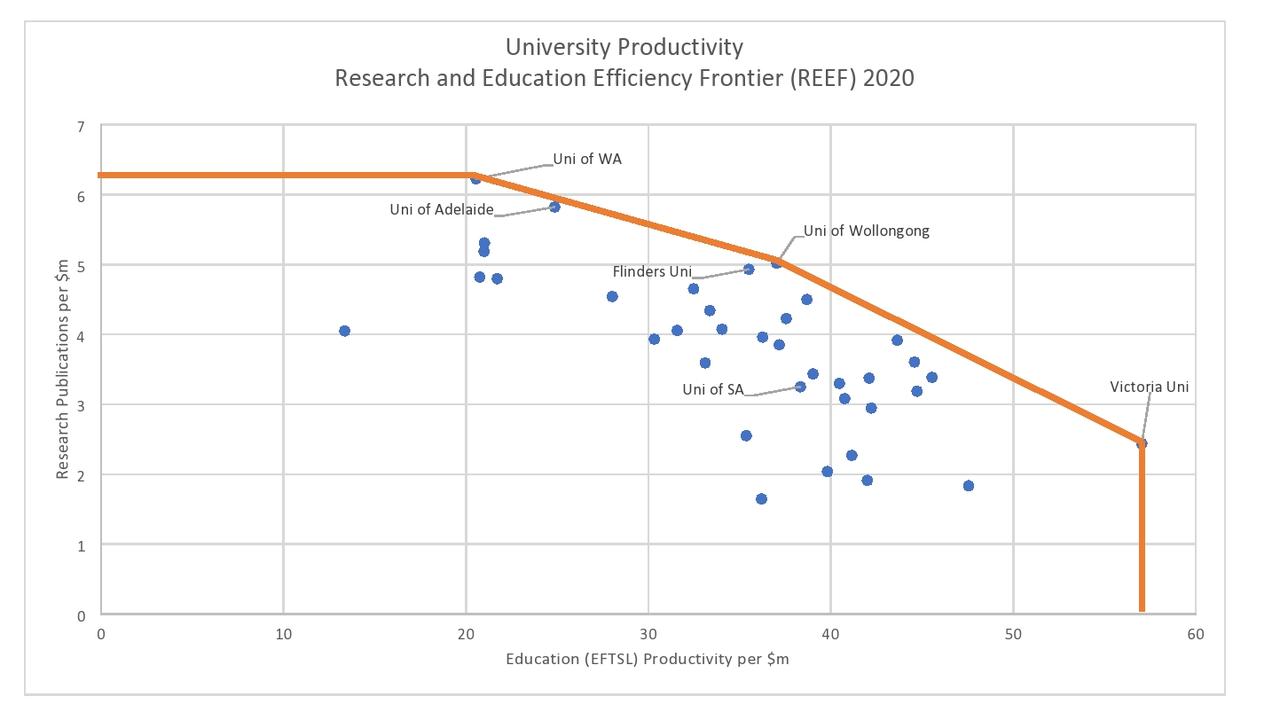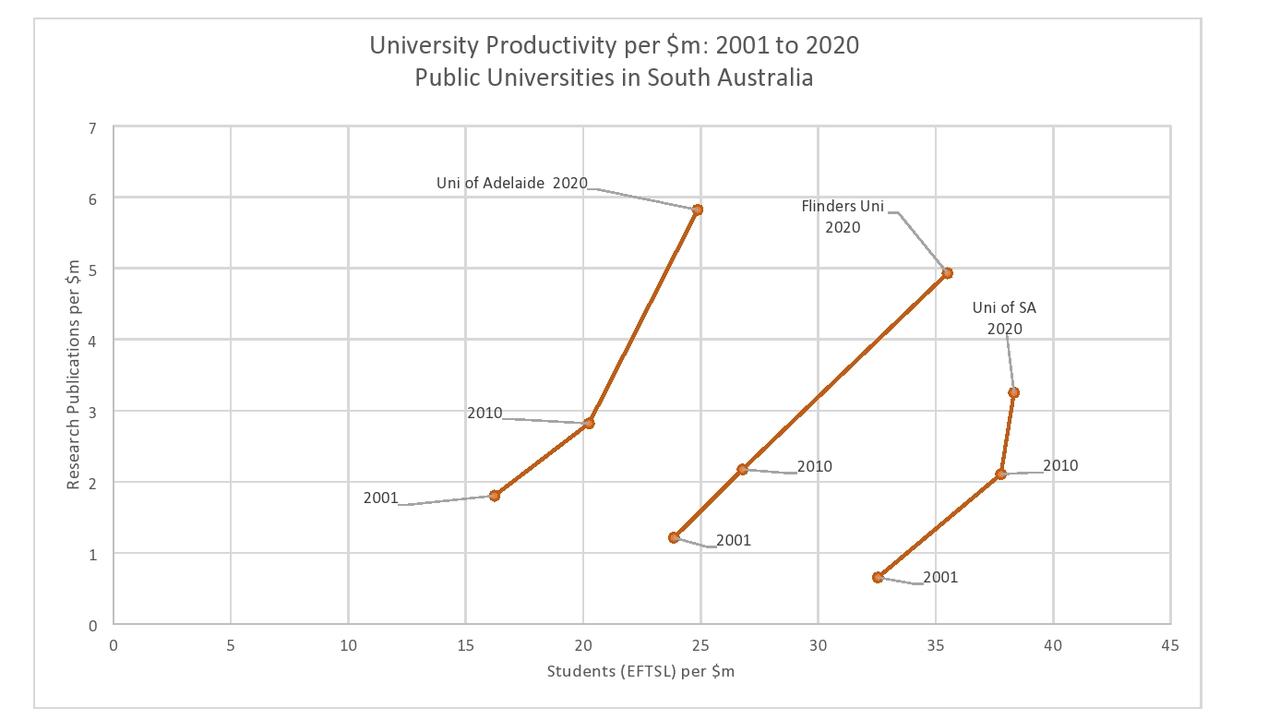Productivity is the crucial, but unmentioned, word in the SA uni merger


His analyses, which he publishes regularly (including in this newspaper), are revealing. They show how much it costs individual universities (in both money and academic time) to produce a research paper or to graduate a student.
It’s important work for two reasons. First, because public money is spent on universities, and we need accountability for how it is spent, And second, because the Australian higher education system is highly regulated and, quite rightly, not an unfettered marketplace. The free market does not deliver a verdict on the performance of universities. We need extra analysis to throw light on this.
His work also casts light on other questions such as: are there economies of scale in universities? That is, are larger universities more cost efficient? And is there a point at which greater size (in student numbers) leads to diseconomies of scale where the institution loses efficiency?
Houghton’s work is revealing. It shows that in 2020, the year of the latest available data, the three Australian universities on the efficiency frontier were the University of Western Australia, the University of Wollongong and Victoria University. None of the three is large – ranging between 18,000 and 25,000 full-time equivalent students – but each is most efficient in its class.

UWA is research intensive and more efficient in research than teaching. Victoria is teaching intensive and more efficient in its teaching than research. And Wollongong is efficient in both research and teaching.
This leads to an obvious question. Currently the University of Adelaide and the University of South Australia are pushing ahead with a detailed feasibility study into a proposed merger that would create a combined institution of 50,000 students.
Would the new Adelaide University, as they plan to call it, operate more cost efficiently?
“An assessment of the impact on teaching and research cost structures will be a key consideration in any analysis of a potential merger,” says Houghton, who is now with the Higher Education and Research Group.

“As at 2020, the latest official data available, the average level of cost efficiency of the three South Australian public universities outperforms the average cost efficiency observed in all other mainland states.”
In other words, pursuit of cost efficiency is not, in itself, a reason why university mergers should be implemented in South Australia. Its universities (including Flinders, which is not part of the merger proposal) already operate at high efficiency.
.

If the merger goes ahead, which will be decided mid-year when the feasibility study and business plan are complete, the first thing will be to ensure that greater size does not make the combined institution less efficient. “If a merger of the current universities of South Australia and Adelaide results in no diseconomies of scale – which will be key – and is able to capture the comparative cost advantages of the University of South Australia in teaching and the comparative cost efficiencies in research at the University of Adelaide, then, over time, the merged entity will have the potential to become a powerhouse in Australian higher education,” Houghton says.
The point he is making is that the two universities have different strengths. Adelaide, the research-intensive university, is more efficient at research. UniSA, which is more focused on teaching, is more efficient at teaching.
In a merger, if the two universities can share their strengths and bury their weaknesses, then the combined entity could be stronger than the sum of its parts.
But the published merger proposal (see here and here) doesn’t refer to productivity or efficiency. Certainly, mention of these words won’t help persuade skittish staff who fear what it means for their jobs, particularly in areas where the two universities have duplication. In fact staff at both universities have been promised there will be no net job losses as a result of a merger.
But productivity improvement is, in fact, fundamental to the merger’s success. The ultimate reason behind the push to merge is the fact that the University of Adelaide is a research-intensive, Group of Eight university that doesn’t have a sufficient student base, either in domestic or international students, to fund the level of research it needs.
It’s no accident that Australia’s big five, research-rich, universities – Sydney, NSW, Melbourne, Monash and Queensland – all have more than 40,000 students, in some cases much more. They also all have a large proportion of high fee-paying international students in the mix. The University of Adelaide doesn’t play in the same league and unless it can boost its research funding it will fall further and further behind.
So the plan is twofold. A merger will boost student numbers and hopefully push the new university higher in most rankings and thus attract more international students. The downside is that it relies on what has become a feature of the Australian higher education funding system – skimming the cream off fees that students (both domestic and international) pay for courses in order to invest in research.
Viewed in this way, the plight of UniSA students does not look attractive. They are fated to be the milch cows whose course fees will be tithed to bolster the University of Adelaide’s flagging research budget.
Unless, of course, the merger does produce productivity benefits, and the new institution manages to retain the high teaching productivity of UniSA and the high research productivity of the University of Adelaide. Then there will be a genuine surplus to put into research.
Is this feasible? A glance at the REEF index graph above shows that no university in Australia currently achieves that level of efficiency. But that doesn’t mean it’s impossible, just difficult. Can it hurt to aim high?



For several years economist Keith Houghton, a former business and economics dean at the Australian National University, has been gathering data on the productivity performance of Australian universities to give a picture of the efficiency of their research and the efficiency of their teaching.